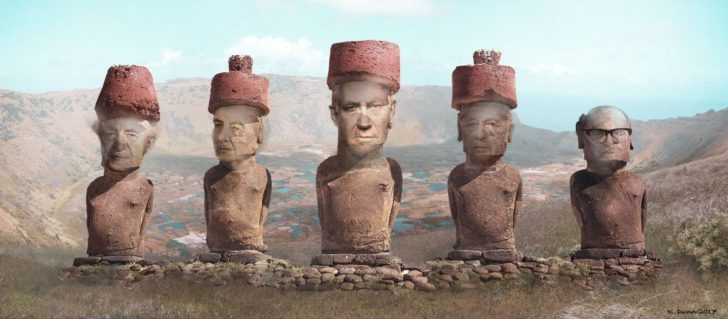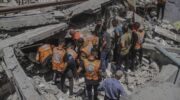Part 5 of a 12 part series examining the ecological impacts of Israel’s occupation of Palestine.
A synopsis of the findings is here.
by Dick Callahan, reposted from DickCallahan.net
The lower Jordan river is a wreck
“The river one hundred twenty feet wide and six feet deep, gravelly bottom; current five knots.” W.F. Lynch, USN, Commander of the Jordan River Expedition, in 1848.
“All our lives we had studied and sung about this stream so we visualized a mighty current with almost magical qualities. We were amazed to find that it was not as large as the small creeks that flow through our own farm.” Former President Jimmy Carter on his 1973 swim in the Jordan River
Lower Jordan
Historically the lower Jordan was a decent size river that discharged 1.4 billion cubic meters per year into the Dead Sea. That’s an average of about 44.4 cubic meters per second. Today the Jordan discharges about 30 mcm per year (0.95 cubic meters per second). For perspective, the medium-small Mendenhall river just north of my town flows at an average of 36.5 cubic meters per second. The fairly-huge Taku river south of Juneau flows at 380 cubic meters per second. [per second flows are annual averages because rivers are subject to wide annual and seasonal fluctuations depending on rain, snow, drought, flash floods and local factors like spring runoff or glacial lake outbursts, etc.]
Water no longer fills the Jordan river because Israel, Syria and Jordan take 98 percent of the historical flow. The remaining two percent is contaminated with human feces, agricultural runoff, brine extrusions diverted from Lake Kinneret, and industrial chemical wastes that would be unimaginable to our ancestors bathing in the holy river
The 21st century baseline is a Lower Jordan Valley where over half of the 1800’s biodiversity is gone. Captain Lynch’s 1848 baseline of the Jordan River is more valuable and interesting reading than a hundred of the academics who followed. Going from north to south Lynch writes:
pg 101 “The average breadth about seventy-five feet…Water clear and ten feet deep.” [just after embarking into the lower Jordan from Lake Kinneret. Lynch notes abundant water fowl, storks, burnoose, pigeons, doves, bulbuls, as well as wild boar, big cats and other wildlife along the banks and inhabiting marsh grass, reedy islands.]
pg 102 at the bridge of Semakh. The river was about ninety feet wide, the water, “rushed like a mountain torrent” over debris from the fallen bridge.”
pg 103 “The soil here is a dark rich loam, luxuriantly clothed, three feet deep with flowers.”
pg 105 “starting again we descended a cascade at a rate of twelve knots.”
pg 114 Yarmouk River was one hundred thirty feet wide where it entered the Jordan.
pg 143 “large fields of wheat and barley…”
pg 157 “passed under an overhanging tree, with a bush fifteen feet up in its branches, lodged there by the recent freshet.” [near ford of Damieh on the road from Nablus.]
pg 160 “The river, one hundred and twenty feet wide and seven deep, was flowing at a rate of six knots down a rapid descent.”
pg 167 [on almost getting trampled by thousands of Christian pilgrims] “Nothing but the spears and swarthy faces of the Arabs [the expedition’s companions and guards] saved us.”
pg 170 “the river is in the latter stage of a freshet—a few weeks earlier or later, and passage would have been impracticable…we have plunged down twenty-seven threatening rapids, besides a great many of lesser magnitude.”
pg 171 [near north end of the Dead Sea by Wadi Hesbon] “the river here is fifty yards wide, eleven feet deep, muddy bottom, current four knots…water of the river is sweet.”
Modern pilgrims to the banks of the Lower Jordan can still be baptized in a trickling sewer that regularly makes lists of the world’s most polluted rivers. There are reports of Israeli tour guides steering the faithful to sites where the water looks cleaner. Israel’s Health Ministry has been accused of leaving Christian baptismal sites open for pilgrim-dunking when fecal coliform there measures six times higher than concentrations where the Ministry closes Israeli beaches to swimming. If you buy into those American televangelist shows where they sell Holy Land tours, you might want to skip that part where you can get baptized in the Jordan.
The Shrinking Dead Sea and two old, “ain’t-gonna-happen” pipe dreams to fix it
Because of over pumping the Jordan River and its tributaries, the Dead Sea has dropped by more than 40 meters (131 feet) since the 1950’s and continues to waste down at about a meter per year. Buildings that stood on the shore when Israel was founded are now two kilometers away. Tractors pull carloads of tourists from their hotels to the water. Roads are being diverted and beaches closed because thousands of sinkholes, many large enough to swallow people, cars, and even buildings, are opening up due to lack of water.
Technological solutions have been kicked around for over a hundred years. Two such are the “Red to Dead” and the “Med to Dead” projects. The former would be a joint effort between Israel and Jordan to desalinate Red Sea water. The fresh water would be divided between Jordan and Israel. The resulting brine would be pumped through a pipeline to replenish the Dead Sea. According to EcoPeace Middle East co-director Gidon Bromberg says the plan would mean the Dead Sea will continue to drop by 1.1 meters per year instead of the 1.1 to 1 1.2 meters per year that it’s dropping now and would cost as much as three times the projected $10 billion price tag.
“Med to Dead” proposes running Mediterranean Sea water to the Dead Sea via 100 kilometers of buried pipeline, with the 400 meter drop at the end being used to run turbines for electric power as the water replenishes the Dead Sea. EcoPeace Mideast’s Bromberg has questioned whether this is even a serious proposal, or just political palaver, but says such a project would contaminate Israel and Palestine’s most vital aquifers (the Coastal and Mountain aquifers) with salt because such pipelines always leak. Previous studies by the UN and World Bank have drawn the same conclusion. As a starting point for a more viable solution Bromberg points out that 50 percent of the Dead Sea’s annual decline is caused by the Dead Sea Works which gets the water for free. Giving them incentive to save water would be more productive than a pipeline. In addition, he points out that the Dead Sea has always been fed by fresh water and that putting salt water in it would exacerbate the Sea’s water quality problems.
What the Med to Dead and Red to Dead have in common is that both proposals have been around since before any of us were born, both would create their own sets of environmental problems, both would be incredibly expensive, neither has been built and most likely neither will be built.
(*Graphic at top by artist Kari Dunn http://kdunnart.weebly.com)
Recognition 5: Lower Jordan and Dead Sea are wrecks: Selected Sources
2006 Palestine: Peace Not Apartheid by former President Jimmy Carter, Simon & Schuster.
03.01.1850 Narrative of the United States expedition to the River Jordan and the Dead Sea, by W.F. Lynch, USN, Commander of the Expedition, 386 pp. Lea and Blanchard, Philadelphia.
May, 2010 Towards a Living Jordan River: An environmental flows report on the rehabilitation of the lower Jordan River collaboration between Friends of the Earth Middle East, Global Nature Fund, Goldman Fund, USAid, Green Environment Fund. Lead authors: Sarig Gafny, Samer Talozi, Banan Al Sheikh, Slisabeth Ya’ari.
06.18.2015 Baptism by mire? In lower Jordan River, sewage mucks up Christian right Times of Israelby Melanie Lidman.
Winter, 2007. Israel’s Water Deficit B’Nai B’rith by Uriel Heilman. “When pilgrims travel to Israel and find their way to the Jordan River to see where Jesus was baptized, their reaction is invariably the same. Their jaws drop. Expecting to see the raging river described in the Bible, they come upon a sewage-laden trickle. Though savvy Israeli tour guides have learned to carefully steer their charges to spots where the Jordan appears deeper and cleaner, the river remains a microcosm for the dismal state of Israel’s waterways, nearly 60 years after the founding of the Jewish state.”
04.09.2015 The Death of the Dead Sea: Once a wonder, today a sink hole Haaretz by Nir Hassan.
04.17.2015 Geologists: Road along Dead Sea must be diverted towards nature reserve Haaretz by Nir Hasson.
10.07.2016 The Dead Sea is dying fast: Is it too late to save it or was it always a lost cause? Haaretzby Hagal Amit.
08.16.2017 Experts say Red Sea-Dead Sea pipedream isn’t worth its salt Times of Israel by Melanie Lidman
05.21.2016 EcoPeace slams Med-Dead Sea Conduit Globes:Israel’s Business Arena





